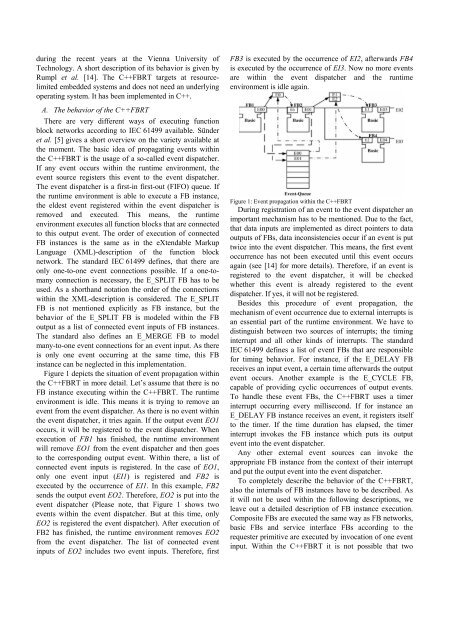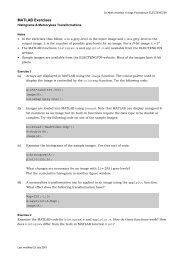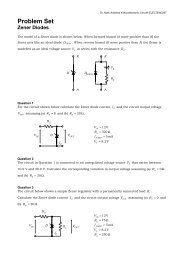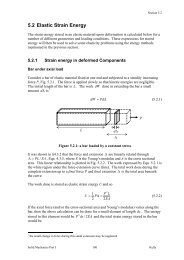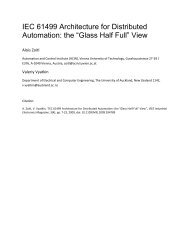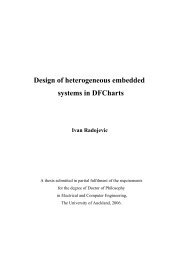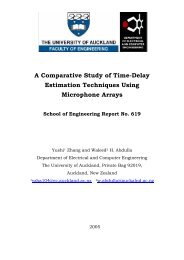Formal description of IEC 61499 control logic with - The University of ...
Formal description of IEC 61499 control logic with - The University of ...
Formal description of IEC 61499 control logic with - The University of ...
You also want an ePaper? Increase the reach of your titles
YUMPU automatically turns print PDFs into web optimized ePapers that Google loves.
during the recent years at the Vienna <strong>University</strong> <strong>of</strong><br />
Technology. A short <strong>description</strong> <strong>of</strong> its behavior is given by<br />
Rumpl et al. [14]. <strong>The</strong> C++FBRT targets at resourcelimited<br />
embedded systems and does not need an underlying<br />
operating system. It has been implemented in C++.<br />
A. <strong>The</strong> behavior <strong>of</strong> the C++FBRT<br />
<strong>The</strong>re are very different ways <strong>of</strong> executing function<br />
block networks according to <strong>IEC</strong> <strong>61499</strong> available. Sünder<br />
et al. [5] gives a short overview on the variety available at<br />
the moment. <strong>The</strong> basic idea <strong>of</strong> propagating events <strong>with</strong>in<br />
the C++FBRT is the usage <strong>of</strong> a so-called event dispatcher.<br />
If any event occurs <strong>with</strong>in the runtime environment, the<br />
event source registers this event to the event dispatcher.<br />
<strong>The</strong> event dispatcher is a first-in first-out (FIFO) queue. If<br />
the runtime environment is able to execute a FB instance,<br />
the eldest event registered <strong>with</strong>in the event dispatcher is<br />
removed and executed. This means, the runtime<br />
environment executes all function blocks that are connected<br />
to this output event. <strong>The</strong> order <strong>of</strong> execution <strong>of</strong> connected<br />
FB instances is the same as in the eXtendable Markup<br />
Language (XML)-<strong>description</strong> <strong>of</strong> the function block<br />
network. <strong>The</strong> standard <strong>IEC</strong> <strong>61499</strong> defines, that there are<br />
only one-to-one event connections possible. If a one-tomany<br />
connection is necessary, the E_SPLIT FB has to be<br />
used. As a shorthand notation the order <strong>of</strong> the connections<br />
<strong>with</strong>in the XML-<strong>description</strong> is considered. <strong>The</strong> E_SPLIT<br />
FB is not mentioned explicitly as FB instance, but the<br />
behavior <strong>of</strong> the E_SPLIT FB is modeled <strong>with</strong>in the FB<br />
output as a list <strong>of</strong> connected event inputs <strong>of</strong> FB instances.<br />
<strong>The</strong> standard also defines an E_MERGE FB to model<br />
many-to-one event connections for an event input. As there<br />
is only one event occurring at the same time, this FB<br />
instance can be neglected in this implementation.<br />
Figure 1 depicts the situation <strong>of</strong> event propagation <strong>with</strong>in<br />
the C++FBRT in more detail. Let’s assume that there is no<br />
FB instance executing <strong>with</strong>in the C++FBRT. <strong>The</strong> runtime<br />
environment is idle. This means it is trying to remove an<br />
event from the event dispatcher. As there is no event <strong>with</strong>in<br />
the event dispatcher, it tries again. If the output event EO1<br />
occurs, it will be registered to the event dispatcher. When<br />
execution <strong>of</strong> FB1 has finished, the runtime environment<br />
will remove EO1 from the event dispatcher and then goes<br />
to the corresponding output event. Within there, a list <strong>of</strong><br />
connected event inputs is registered. In the case <strong>of</strong> EO1,<br />
only one event input (EI1) is registered and FB2 is<br />
executed by the occurrence <strong>of</strong> EI1. In this example, FB2<br />
sends the output event EO2. <strong>The</strong>refore, EO2 is put into the<br />
event dispatcher (Please note, that Figure 1 shows two<br />
events <strong>with</strong>in the event dispatcher. But at this time, only<br />
EO2 is registered the event dispatcher). After execution <strong>of</strong><br />
FB2 has finished, the runtime environment removes EO2<br />
from the event dispatcher. <strong>The</strong> list <strong>of</strong> connected event<br />
inputs <strong>of</strong> EO2 includes two event inputs. <strong>The</strong>refore, first<br />
FB3 is executed by the occurrence <strong>of</strong> EI2, afterwards FB4<br />
is executed by the occurrence <strong>of</strong> EI3. Now no more events<br />
are <strong>with</strong>in the event dispatcher and the runtime<br />
environment is idle again.<br />
Figure 1: Event propagation <strong>with</strong>in the C++FBRT<br />
During registration <strong>of</strong> an event to the event dispatcher an<br />
important mechanism has to be mentioned. Due to the fact,<br />
that data inputs are implemented as direct pointers to data<br />
outputs <strong>of</strong> FBs, data inconsistencies occur if an event is put<br />
twice into the event dispatcher. This means, the first event<br />
occurrence has not been executed until this event occurs<br />
again (see [14] for more details). <strong>The</strong>refore, if an event is<br />
registered to the event dispatcher, it will be checked<br />
whether this event is already registered to the event<br />
dispatcher. If yes, it will not be registered.<br />
Besides this procedure <strong>of</strong> event propagation, the<br />
mechanism <strong>of</strong> event occurrence due to external interrupts is<br />
an essential part <strong>of</strong> the runtime environment. We have to<br />
distinguish between two sources <strong>of</strong> interrupts; the timing<br />
interrupt and all other kinds <strong>of</strong> interrupts. <strong>The</strong> standard<br />
<strong>IEC</strong> <strong>61499</strong> defines a list <strong>of</strong> event FBs that are responsible<br />
for timing behavior. For instance, if the E_DELAY FB<br />
receives an input event, a certain time afterwards the output<br />
event occurs. Another example is the E_CYCLE FB,<br />
capable <strong>of</strong> providing cyclic occurrences <strong>of</strong> output events.<br />
To handle these event FBs, the C++FBRT uses a timer<br />
interrupt occurring every millisecond. If for instance an<br />
E_DELAY FB instance receives an event, it registers itself<br />
to the timer. If the time duration has elapsed, the timer<br />
interrupt invokes the FB instance which puts its output<br />
event into the event dispatcher.<br />
Any other external event sources can invoke the<br />
appropriate FB instance from the context <strong>of</strong> their interrupt<br />
and put the output event into the event dispatcher.<br />
To completely describe the behavior <strong>of</strong> the C++FBRT,<br />
also the internals <strong>of</strong> FB instances have to be described. As<br />
it will not be used <strong>with</strong>in the following <strong>description</strong>s, we<br />
leave out a detailed <strong>description</strong> <strong>of</strong> FB instance execution.<br />
Composite FBs are executed the same way as FB networks,<br />
basic FBs and service interface FBs according to the<br />
requester primitive are executed by invocation <strong>of</strong> one event<br />
input. Within the C++FBRT it is not possible that two


